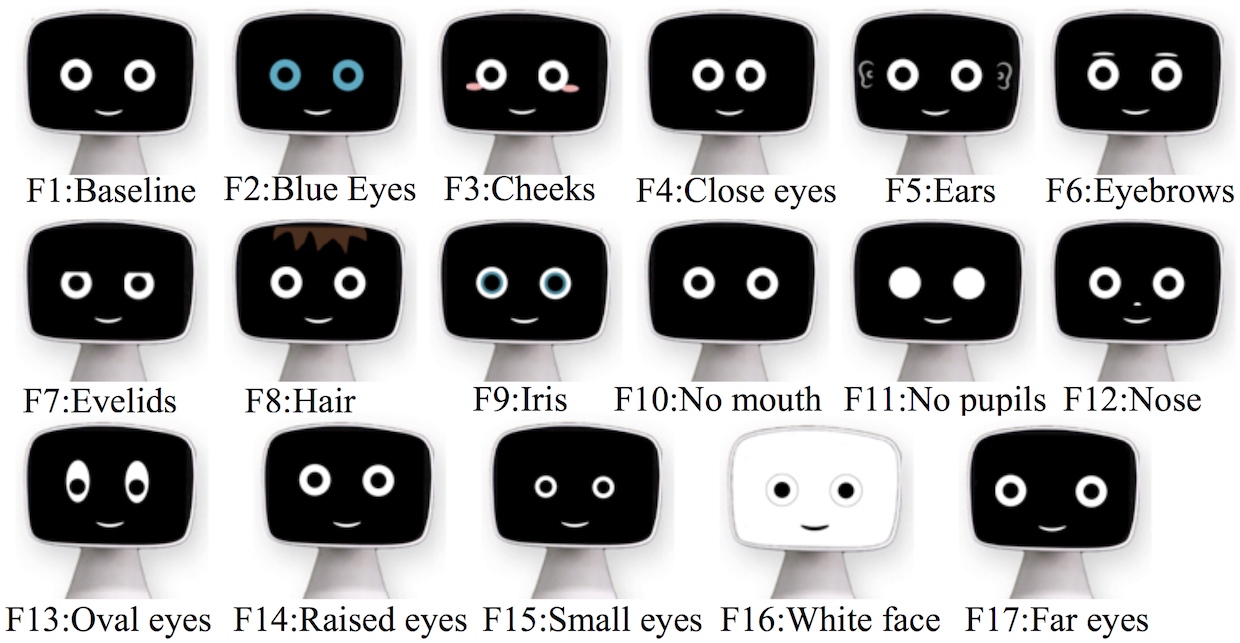 The basic models of robolits, taken as the basis of the first phase of the study (altogether 157 robolits were studied). Instances are sorted from left to right by increasing detail. The number on the scale corresponds to the number of missing items, such as the eyebrows or the mouth. Illustration: University of Washington
The basic models of robolits, taken as the basis of the first phase of the study (altogether 157 robolits were studied). Instances are sorted from left to right by increasing detail. The number on the scale corresponds to the number of missing items, such as the eyebrows or the mouth. Illustration: University of WashingtonThe ACM / IEEE international conference on human interaction with robots in March 2018 (HRI 2018)
presented the results of a large-scale study “Characterizing the Design Space of Rendered Robot Faces”. Immediate to the uninitiated person is difficult to understand what it is about. What else is rendering?
The fact is that recently the creators of humanoid (and not only) robots install computer screens for them instead of iron faces. On the screen, a robot can demonstrate the whole gamut of feelings - smile or frowning ominously - and for this you will not have to mount dozens of expensive servomotors to emulate facial expressions.
So, Washington scientists under the leadership of Alice Kalegina for the first time studied in detail how people react to changes in the characteristics of the robot's face.
The base for the study were the faces of 157 robots found on the Internet. Each copy was assigned the appropriate characteristics: the presence of an element; item color; The size, shape, and location of each element on the face. The researchers also recorded a number of other useful characteristics, such as the name of the robot model and the country of design.
The statistics collected already at this stage is very curious. For example, every third robot in the world has a black face. Most robots have mouths, but no nose, cheeks and eyebrows. The most popular eye shape is round. Only 10% of robots have eyes of the same shape as humans. Two obvious clusters also appeared:
faces in the style of Baxter and
faces in the style of EVE .
At the first stage, each of the 50 respondents was shown faces of 12 selected robots and asked to evaluate six face parameters on a five-point scale, and also indicate the most appropriate profession for this robot.
The most "friendly" respondents considered robots Yumi, FURo-D, Buddy and Datou. The least friendly are Jibo and Gongzi.
The most intelligent were impressed by the friendly FURo-D and the unfriendly Gongzi. The silliest are Sawyer, Buddy and Datou.
In terms of trust, FURo-D won, and Gongzi is the least trustworthy. In general, with respect to the Gongzi robot, many respondents expressed a subjective opinion that he had an “evil face”.
At the next stage, the researchers tried to find out what specific signs influence the impression of the robic, and how changing these signs changes the human perception of the face.
 A set of individuals who were used in the second phase of the study. The face in the upper left corner is taken as the base or “middle face”. All other persons are slightly different from the base due to the change of one sign. Illustration: University of Washington
A set of individuals who were used in the second phase of the study. The face in the upper left corner is taken as the base or “middle face”. All other persons are slightly different from the base due to the change of one sign. Illustration: University of WashingtonAs it turned out, none of the changed faces show a noticeably greater friendliness than the base person. There was a marked decrease in friendliness in persons with a missing mouth, missing pupils and slightly lower eyelids.
The sign of “eyebrow” correlates most strongly with intellect. In this case, the eyebrows are designed in such a way that they are lowered close to the eyes, so as not to create the effect of a child’s face. In this case, when evaluating intelligence, the opposite effect is observed. A similar effect of stupidity is created by faces with close-set eyes, no mouth and cheeks (F3).
The results of the study make it clear how designers should design the faces of robots depending on their duties. For example, if you are designing a robot guard, then make sure that he has no mouth on his face and there are eyelids. Maintenance robots will benefit from eyebrows, and entertainment robots should have better detail than other human-like machines.
The scientific article was
published in the collection of materials from the conference HRI 2018, which took place on March 5-8, 2018 (doi: 10.1145 / 3171221.3171286).